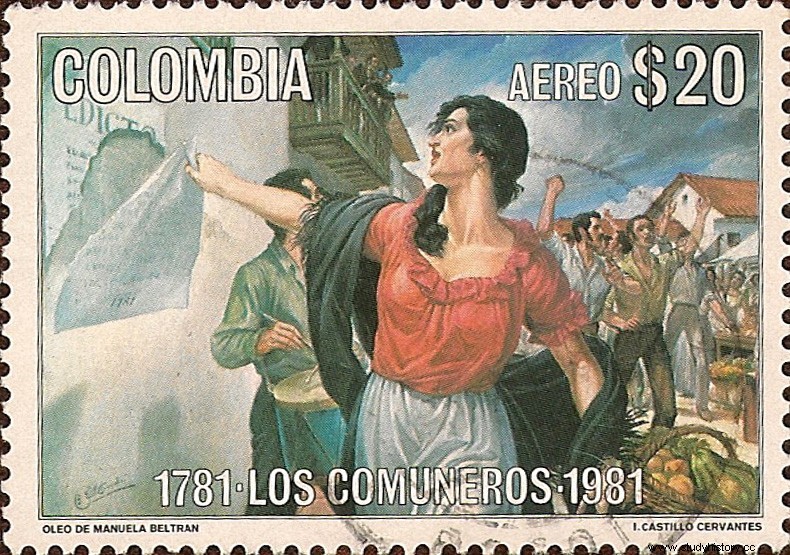In the 1780s, Manuela Beltrán led the revolt of the Comuneros in the Viceroyalty of New Granada (in present-day Colombia). against the Spanish authorities and their excessive taxation system.

Little is known about the life of Manuela Beltrán. Coming from a modest family descended from Spaniards, she was born around 1750. She spent most of her life in the city of Socorro, in the Viceroyalty of New Granada (in present-day Colombia, then under Spanish). Owner of a small grocery store, Manuela is one of the few people in town who can read and write.
Revolts and riots
At that time, the Spanish Empire was striving to maintain control of its American colonies, financing the development of its military forces through the exploitation of conquered and colonized territories. Alongside the development of large agricultural estates and the exploitation of precious deposits, new taxes were introduced or developed on the consumption of brandy and tobacco, on the importation of goods and on sales .
During the 18th century, several revolts broke out against certain reigns of the colonial empire, notably in 1752 and in 1764-1767 against the monopoly of the aguardiente (brandy). In 1779, 1,500 Amerindians rose up against the occupier, but their revolt was suppressed.
The Barlovento Armada
In 1781, the Visitador Regente , officer of the Crown and second authority figure behind the viceroy, Juan Francisco Gutiérrez de Piñeres, decides to relaunch the old tax of the Armada de Barlovento; this tax on sales, relating in particular to cotton, hits hard the region of Socorro which produces textiles in particular.
In March 1781, the tax notice was posted in the central square in Socorro. Being among the few who know how to read, it is Manuela Beltrán who informs the crowd of the decision of the Visitador Regente . Outraged, she tore up the notice shouting:"Viva el Rey, abajo el mal gobierno!" No queremos pagar la Armada de Barlovento! » (Long live the king, down with bad government! We don't want to pay the Barlovento Armada!). His gesture spurs what will be known as the revolt of the Comuneros.
The revolt of the Comuneros
At first, the insurgents are among the poorest of the population. As the movement spread to some sixty towns and villages in the region, it was joined by merchants, craftsmen and Native American communities. The demands of the movement extend to the restitution of lands stolen from the natives.
20,000 men, led by Juan Francisco Berbeo [Spanish], Salvador Plata, Antonio Monsalve and Francisco Rosillo, marched towards Santafe (now Bogota). They are stopped on the way by Spanish troops, and negotiations begin near Zipaquirá. The negotiating committee then accepted all of the 35 demands of the insurgents, including the abolition or reduction of taxes, freedom of trade, better representation of indigenous people in administrative jobs and amnesty for the insurgents.
But Viceroy Manuel Antonio Flores refuses to recognize the agreements signed. A regiment is sent to town; most of the leaders of the revolt are captured, executed and exposed in public places in the most active places of the rebellion. Their goods are confiscated, and the reproach is thrown on their descendants. The fate of Manuela Beltrán, during the repression of the revolt, is not known.
Expression of popular anger against the colonial authorities, the revolt of the Comuneros is considered a first step towards the struggle for independence.
